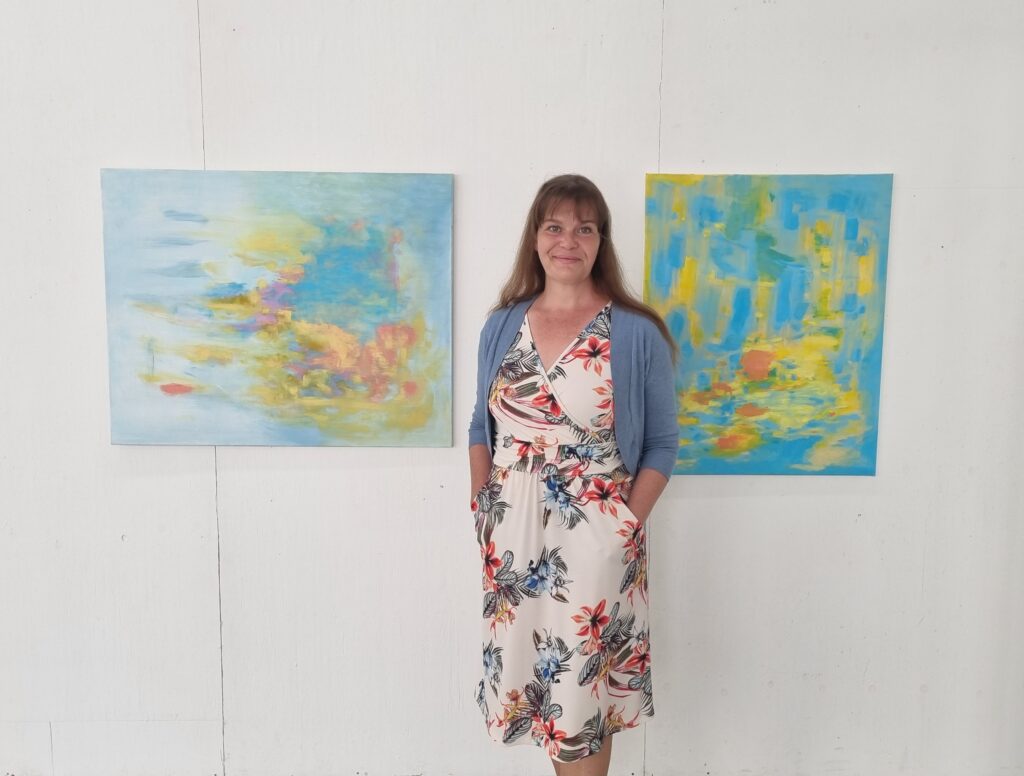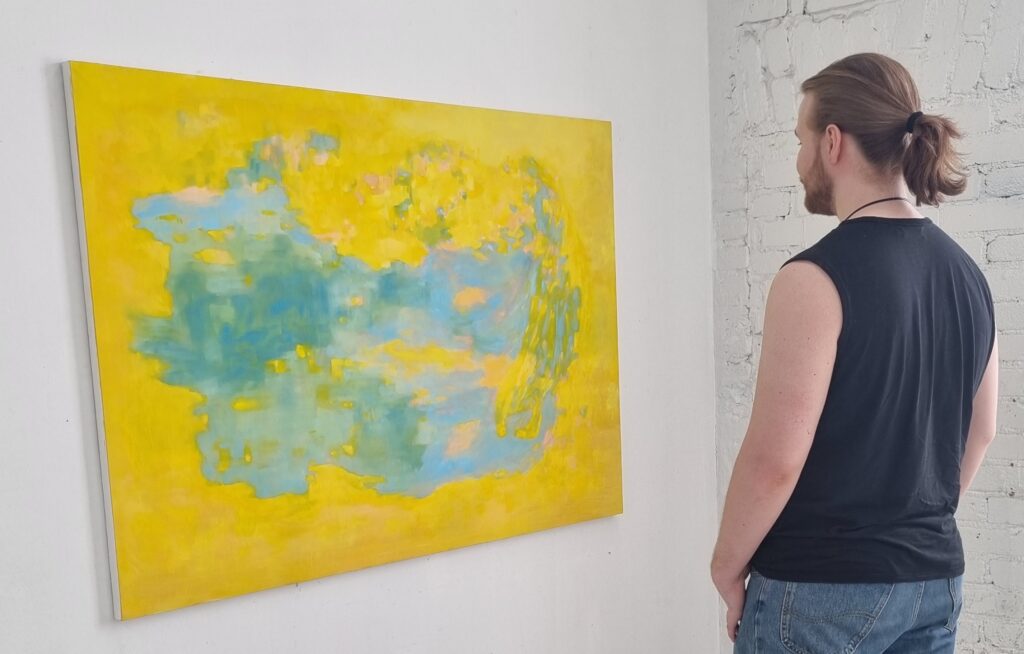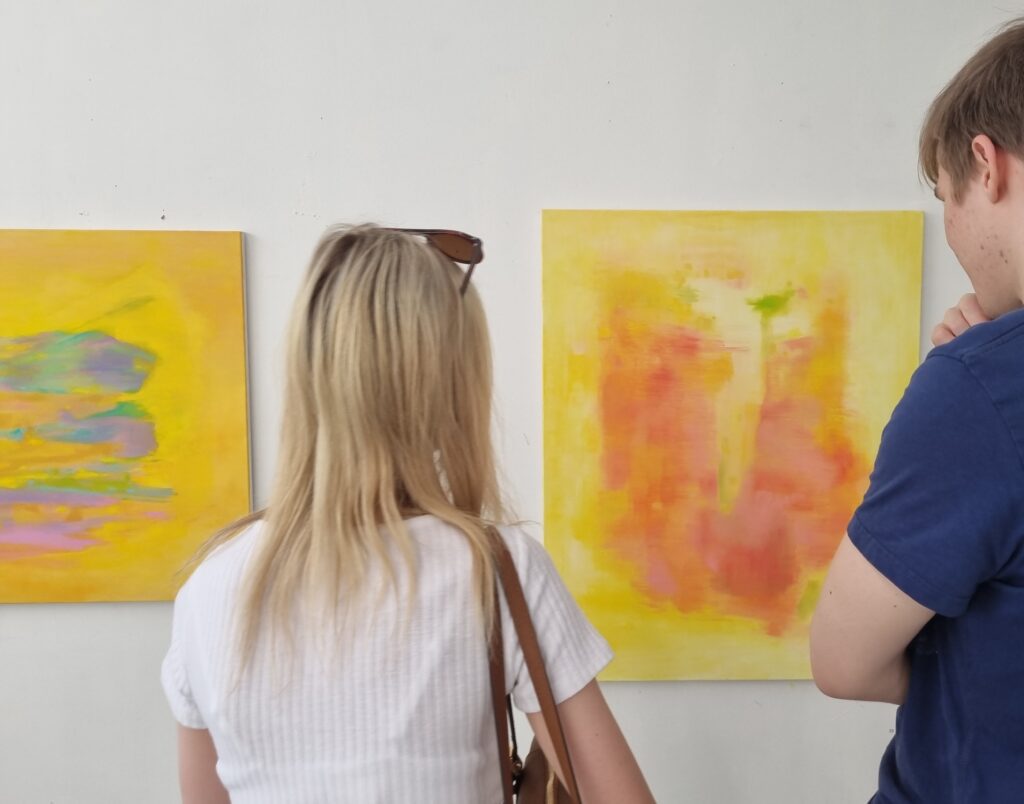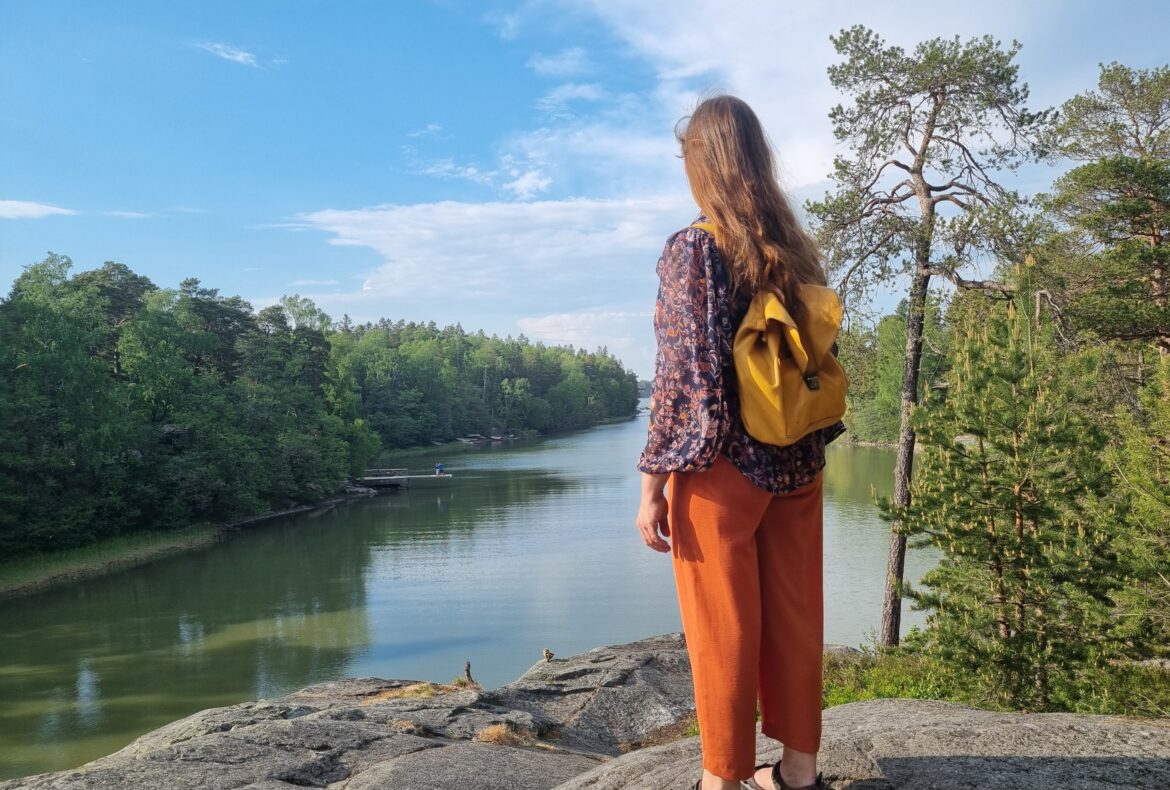In the vibrant world of contemporary art, Satu Metsola stands out as a beacon of creativity and resilience.
Her journey from a childhood surrounded by artistic influences to becoming a renowned curator and artist is a testament to her unwavering passion and dedication. Balancing her roles with grace, Metsola has not only carved a niche for herself in the art world but also inspired many with her story of perseverance, self-discovery and holistic living. Through meditation, she has harnessed the power of mindfulness to fuel her artistic endeavours, creating works that resonate deeply with emotional and spiritual insights.
Satu Metsola’s story is a powerful reminder that embracing one’s true self and passions can lead to a fulfilling and impactful life…

1. Can you share the story of your journey into the world of art and what sparked your initial interest in painting and curating
I have had a lifelong passion for art since early childhood. My mother, a keen sculptor, introduced me to art at a very young age. She took me with her to her classes, where I was immersed in a creative environment filled with the mixture of plaster and clay lingering in the air. The atmosphere was charged with creativity, with adults concentrating on their work and the intriguing figure of the teacher walking amongst them. I made several sculptures before the age of 9, but my greatest passion was drawing. Being around art and artists has always been an inner necessity for me.
I began studying art in my early twenties, dividing my time between art history studies at the University and art classes at the Academy of Fine Arts. I focused on completing my Master’s degree at the University. Soon after, I became a mother of two lovely sons, graduated, and got a job as an Assistant Curator at the Museum of Contemporary Art Kiasma. I then became a Curator there, eventually a Chief Curator at Kunsthalle Helsinki, and later worked on the inaugural Helsinki Biennial. Fantastic projects followed each other at a fast pace, and I forgot to maintain a healthy work-life balance.
That’s when meditation came into my life, helping me prioritise self-care. I rediscovered the necessity of doing art and started studying at an art school again, spending almost all my evenings and weekends studying for four years. This decision was driven by my desire to create something meaningful and express my emotional and spiritual experiences. Now, I finally feel my life is in balance, filled with art.
2. How does your meditation practice influence your painting process?
Meditation significantly influences my artistic process in various ways. By focusing on the present moment, I can access deeper levels of creativity and inspiration. It helps me clear my mind of clutter and distractions, allowing for a free flow of creation. Regular meditation practice has improved my ability to focus and concentrate on my work for extended periods. I can fully engage with the process, pay close attention to each brushstroke, and approach my work with a calm and centred mindset.
Meditation has also helped me feel a sense of connection to a larger whole and more deeply with my inner self. By observing my practice without judgment, I can transform even the most intense emotions into the canvas, pursuing a deeper, personal vision. It always surprises me how calm and stable the result is when the work is finished.
3. What does a typical day look like for you in Helsinki, balancing creating art and curatorial work?
My typical day starts with a morning meditation, feeding my old rescue cat, grabbing a cup of coffee, and meal-prepping for the entire day. I take the metro to the museum where I work as a Curator and project manager of various exhibitions.
After work, I head to my studio, relax a bit, and start working. There are days when I simply observe the work I’m doing. I can be merciful towards myself and protect my energy. I have developed a detailed schedule that includes dedicated time blocks for both artistic creation and curatorial responsibilities, while also enjoying life. Being flexible helps me navigate without feeling overwhelmed. I usually end my day with a dance exercise, a walk outside, or meeting friends and family, followed by meditating and resting on the sofa with the cat. On the plus side, I sleep very well.
4. Who or what are some of your biggest inspirations, both in your personal life and artistic career?
My biggest inspiration has always been my late grandmother Hilda, who raised me. She was an amazing storyteller with a fantastic sense of humour, a kind and strong independent woman who gave birth to my mother on a refugee train journey in the middle of a winter war. In my artistic career, I am inspired by independent women artists, particularly pioneers like Hilma af Klint.
5. How have your diverse educational experiences, from art history to Finnish literature, shaped your approach to art and curation?
I loved studying at the University; it was a paradise of freedom! I was so thirsty for knowledge that I studied whatever interested me: art history, archaeology, East Asian religions and philosophy, Finnish literature, film and television studies. I even took a few unsuccessful classes in Sanskrit. Only later did I realise that everything I studied came in handy when working with contemporary art! Continuous learning and remaining open to the unknown world, different visions, and ideas is essential for me.
6. Can you talk about themes, ideas, and concepts behind your art?
My practice relies on intuition; I never pre-plan my work. I have tried, but it does not work for me. I see my abstract works as expressions of myself and sometimes universal truths accessed through meditation and intuition. I feel that my art is guided by an intuitive sense of harmony and balance, inner peace, and colours. Despite the harmonious outcomes, I always put myself, my energy, and my experiences into my artworks. For example, some of the paintings tell stories about how I have transformed myself after a loss or heartbreak.
Sometimes the works continue by themselves, such as the oil pastel series “Let’s Go to the Source.” The next one starts where the previous ended. The process always starts with knowing the first colour needed and ends when I know the name of the painting.



7. What is your curatorial philosophy, and how do you select and present works at prominent institutions like HAM Helsinki Art Museum and the Helsinki Biennial?
As a Curator working in an institution, curating is mostly teamwork. We choose the artists and exhibitions together and collaborate occasionally with guest curators. For the inaugural Helsinki Biennial, I was part of a curatorial team. As a coordinating curator, I worked closely with the head curators and the production team. It was the most challenging and rewarding exhibition I have ever been involved in, located on the former military island of Vallisaari. Every artwork’s practical realization and choice of materials were carried out in cooperation with specialists, considering the island’s unique nature and cultural history.
My personal curatorial philosophy emphasises the careful selection and presentation of artworks that engage with environmental themes, sustainability, and ecological awareness. I value site-specific installations that harmonise with natural settings, encouraging viewers to experience art in a more immersive and holistic manner. A curator must balance artistic integrity with accessibility, ensuring that exhibitions are thought-provoking, meaningful, and engaging experiences for audiences. Most importantly, curating means taking care of the artists and the artworks, collaborating, supporting, and making things happen.
8. How do you balance the roles of being both an artist and a curator? Do these roles complement each other or present challenges?
Balancing an artistic career with a curatorial practice can be challenging but very rewarding. It requires careful planning, time management, and a clear understanding of how the two roles can complement each other. I cannot wear both hats simultaneously. Being a curator in an institution limits me in various ways, and my hands are tied in many respects.
I confess that it was a bit terrifying to show my work in an exhibition for the first time after years of inactivity. I was known as a curator, and I felt like I had uninvitedly stepped into another territory, kind of the other side of the art world. Mostly, it was just a limitation I had made up for myself.
9. How does living and working in Helsinki influence your art? Are there specific aspects of Finnish culture that are reflected in your work?
I have to say that the colours and the light of the Finnish summertime, and perhaps a certain need for solitude, quietness, and peace, influence my work.
10. How do collaborations with other artists and different mediums influence your creative process, especially considering projects like the Seven Prisoners VR/film project?
Collaboration with other artists and mediums introduces new perspectives, techniques, and ideas that challenge my own practices. I was involved in Pawel Althamer’s work “Seven Prisoners” as an executive producer. The work was a Polish-Finnish collaboration with inmates of an open prison, and it expanded my horizons in numerous ways. That collaboration stimulated the creativity of all participants through dialogue, common drawing, spontaneous filming processes, shared experiences, imagination, and visions of multiple creators.

11. What was your experience like working on the construction site fence painting project? How do you approach creating art in public spaces compared to traditional gallery settings?
Art in public spaces is accessible to a wide audience, reaching people who might not typically visit galleries. I wanted the piece to create happiness and good energy in the environment. The painting was significantly larger in scale than my usual works and was designed to be visible in outdoor spaces. It needed to survive harsh weather conditions, so durability was carefully considered.
12. How do you see the relationship between art and wellbeing, especially considering your meditation practice? Do you believe art has a healing power?
Both creating and viewing art can reduce stress levels. The act of creating can be meditative, helping to calm the mind and body, while engaging with art can be a soothing and contemplative experience. The mindful creation process requires focus and concentration, helping to stay present in the moment.
13. Where do you see your art and curatorial practice heading in the next five to ten years? Are there any dream projects you hope to pursue?
I try to live in the present moment and remain open to all the possibilities the universe offers me to explore.
14. Do you have a favourite medium to work with, whether it be painting, drawing, or printmaking? How do you decide which medium to use for a particular piece?
I absolutely love drawing; it is the most natural thing for me to do. However, my favorite medium is painting with oil pastels. It is demanding, as the work can’t be easily fixed afterward, showing all the technique mistakes. I never choose a medium; the medium chooses the right day for it. Sometimes it is a slow oil painting with multiple thin layers; other times, it is a rapid and immediate oil pastel. Recently, I have also started experimenting with clay sculpting.
15. What advice would you give to emerging artists who are just starting their careers and looking to find their unique voice?
Always stay true to yourself.
16. Outside of art and curating, what are some of your hobbies or interests? How do these activities feed into your creative practice?
I love to travel! A few years ago, I started solo traveling, visiting places like New York, Iceland, Ireland, Poland, and Lithuania. Last summer, my adult sons and I traveled by bus around Albania. I also have an old and large garden full of fruit trees, berries, and flowers. I’m really inspired by the British cottage garden style. Both hobbies give me inspiration for my paintings, especially in using colours amidst November greyness. I also feel very relaxed having meditative forest walks or laying on the beach with a good book.
17. Can you share a particularly memorable moment or achievement from your career that holds a special place in your heart?
The most memorable moment was when a young person came to me and said, “Remember always that you were the biggest inspiration for me to have the courage to change the direction of my life.” I think there can’t ever be any achievement better than this.
18. How do you view the role of art in building and nurturing community? Are there any specific projects or experiences where you’ve seen this impact firsthand?
Art can bring people together and build a sense of community through shared experiences. Participating in group art projects helps people feel connected, supported, and more creative. I have been involved in many such projects: practicing drawing, painting, forming textile sculptures, and installations together. Probably the most impressive project was the filming process with the inmates, which had a massive impact on many lives.
19. Our readers love to travel; what’s your favourite destination around the world and why?
If I must choose only one destination, I will say Greece, especially the Ionian islands like Corfu, Kefalonia, and Ithaca. I love the culture, nature, people, food, colours, cats, sea—just everything. When I leave the islands, I always want to go back immediately.
20. What’s your go-to quote when you are lacking motivation?
“Do not go where the path may lead, go instead where there is no path and leave a trail.” – Ralph Waldo Emerson
21. Where can people follow you and find out more?
You can visit my website and follow me on Instagram.
For more inspiring stories, visit House of Coco.





Comments are closed.